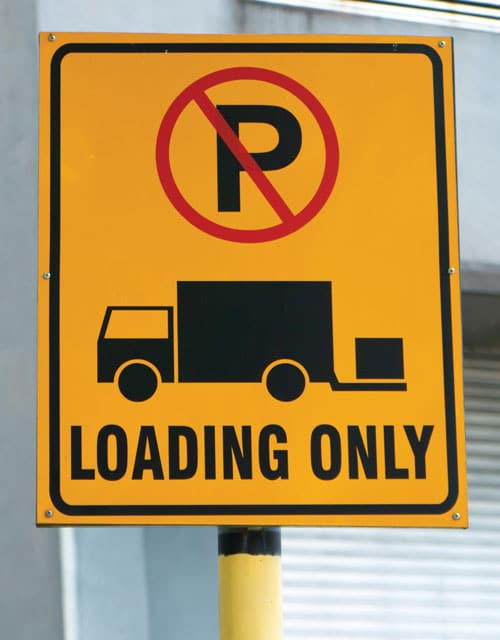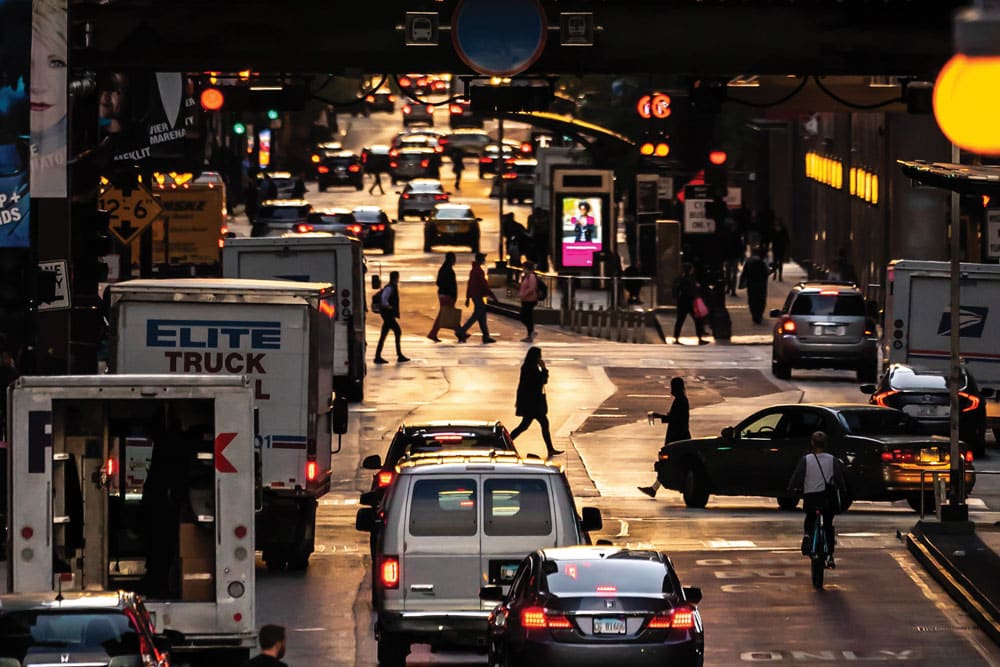Seven Steps to Successful Loading Zone Management
In cities across North America, municipal planners and city leaders are focused on mobility. If people are to move about freely, easily, and safely in our urban environment, city curbs, specifically loading zones, need to be properly managed to permit access by multiple modes of transportation. Today, on the cusp of the age of the smart city and the post-pandemic era, the future of mobility is taking shape, and it begins at the curb.
Why are loading zones so important when it comes to curb management? In short, loading zones tend to serve different types of vehicles, all of which are competing for the same small piece of real estate for a short period of time. Because each type of loading or unloading vehicle has different needs, this competition can be hard to manage and can cause confusion. For instance, transportation network companies (TNCs) and private vehicles dropping off or picking up passengers shouldn’t spend too much time in the loading zone. But what if the rider isn’t ready when the vehicle arrives? How do you keep that vehicle from tying up the curb for too long?
Similarly, curbside pick-up of food and consumer products has become extremely popular since the onslaught of COVID-19. But it can take a while for stores or restaurants to have orders ready and that can cause back-ups on the curb.
Finally, vehicles that are loading and unloading freight tend to be parked much longer than those that are just dropping off or picking up. Additionally, delivery trucks take up a lot more space than a car. So, deliveries tend to tie up more of the curb for longer periods of time than most other uses. It’s enough of a challenge to manage the curb for commercial loading and unloading, but when those vehicles are competing for the same space as curbside drop-offs or pick-ups, the result is often curbside chaos.
This is no small issue. Our curbs are already overstressed by commerce and basic transportation needs. 2.1 billion people purchased goods online in 2021, which resulted in an enormous increase in deliveries. In fact, the world’s largest cities expect a 36% increase in delivery vehicles over the next 8 years. Think about that. The number of delivery vehicles cluttering our city streets will increase by a third!
Already, 28% of the trip time for commercial drivers is spent searching for parking. How much will that number increase with 30% more deliveries taking place? And the impact extends beyond the curb. The increased congestion caused by delivery trucks searching for parking makes city streets less safe and causes significant pollution. Today, 23% of emissions are caused by freight trucks. What will that number look like in 2030?
Obviously, it’s time to rethink the traditional loading zone.
Seven Steps for Success
Step One: Know Your Inventory

The first step is to understand your asset. Where are your loading zones located? How do they relate to nearby parking facilities, pedestrian walkways, micromobility locations, and other transportation resources? What’s the nature of the area they serve—is it a commercial, residential, or mixed-use area? To successfully manage your loading areas, you must fully understand them.
Step Two: Engage Your Stakeholders
Often, the people who are most impacted by urban and transportation plans can provide useful insight into what those plans should look like. There are several ways to get stakeholder input. For instance, town halls can provide a good setting for sharing information and facilitating a back-and-forth dialogue that can lead to great ideas. At the very least, you’ll gain a better understanding of what residents, business owners, and local leaders are looking for from a curb management plan.

Questionnaires and polls are also great ways to gain valuable insight. Because they are anonymous, you may be more likely to get certain types of feedback than in a group setting like town halls and focus groups. One-on-one interviews with key stakeholders can also provide good information that can help with the planning process.
Finally, research can help you better understand who is using your curb space and how. In the past this was done by conducting a utilization study; traditionally, studies were conducted in-person with a paper and pencil, where parking consultants would literally stand on the curb and record which types of vehicles used the curb, how they used it (drop-off, pick-up, or deliveries), and how long they stayed. Today, curb management technology fixed on the curb, such as intelligent camera systems, can continuously record who is using the curb and how, and then transmit that data to a cloud-based application that compiles and analyzes the data.
Step Three: Understand Project Goals
When it comes to curb management, evolution occurs rapidly. Think about it: 10 years ago, no one had ever heard of a TNC. Now, in some communities, they are the dominant user of curb space.

The same goes for technology, which is continuously being introduced. For instance, the introduction of self-driving vehicles will force us to completely rethink our approach to curb management. In creating your curb management goals, it’s not enough to just look at the present; you need to be looking well into the future and assume that your needs are likely to change.
Benchmarking is also an important part of understanding project goals. There is plenty of information out there about what works and what does not work. Cities across North America are implementing curb management practices and they are sharing their successes (and failures) publicly to help other communities, making benchmarking a valuable tool in any municipal planning tool belt. Compare your processes and performance metrics to industry bests and best practices. You will gain a better understanding of which of your strategies are succeeding and why. It will also help you develop new strategies to make your curb management plans more successful as your environment changes and grows.
Step Four: To Charge or Not to Charge

Like traditional parking spaces, charging for loading and unloading is a powerful tool to manage behavior. Cities that charge drivers or fleets for loading are generally more successful at keeping valuable curb space turning over. When drivers are on the clock, they tend to be more efficient. Many of the leading cities in the United States charge loading fees, including Washington D.C., Seattle, Chicago, San Francisco, Aspen, Houston, Nashville, and Miami. Approaches vary, from pricing by the hour to varying pricing by location or vehicle length. Often rates are set to escalate the longer the vehicle stays in the loading space.
Step Five: Communication
Communication is an essential element of any successful curb management plan. If you want drivers and fleets to play by the rules you establish, you need to clearly explain those rules. It is essential to provide concise, easy-to-see, and easy-to-understand signs laying out which types of loading and unloading activities are permitted, where they are permitted, and for how long. If there is a charge for using the space, it should be clearly displayed, and the ways to pay should be convenient.
Step Six: Assess Existing Codes and Restrictions

Codes and restrictions are an essential element of curb management, but the changing needs around the loading zone is a more recently introduced urban planning concept so existing municipal codes may not be appropriate or sufficient to manage new plans. Now is the time to assess existing codes and restrictions to assure that they are relevant to today’s needs, flexible enough for future needs and that they will help achieve the short- and long-term curb management goals that you’ve established.
Step Seven: Technology

In this technology age, it is natural to want the latest and greatest new technologies. But technology is often expensive to install, and just as expensive to operate. You do not want to pay unnecessarily for equipment that does not help you achieve your goals. Nor do you want to have to pay staff to operate that unneeded equipment.
There are several types of equipment that can promote your loading zone goals. For instance, the intelligent camera technology mentioned earlier can also constantly monitor curbs to make sure that only authorized vehicles are using the curb and that they are not staying too long. When there is a violation, the systems can contact enforcement. The systems are affordable and can provide constant oversight, day or night.
Also, Secure Driver Identify (SDI) technology can help manage drop-offs and pick-ups. SDI uses Bluetooth to manage authorized use of loading zones. Each driver is assigned a unique Bluetooth tag or mobile phone profile, which is then read by a sensor located in loading zone. The technology is like the Bluetooth permit readers that are common in university parking facilities to manage parking permits.
Mobile payment apps for commercial loading are another cost-effective technology for managing the curb. Freight companies and their drivers can use the apps to pay required fees, avoiding the risk of tickets and fines (in 2019 UPS’ parking ticket bill in New York City alone was $23 million.) These apps can also be set-up to manage permits, so freight companies don’t have to pay a separate fee for each delivery mobile payment apps benefit freight companies by simplifying the payment process and allowing them to monitor drivers more effectively. They benefit cities by providing data and analytics about delivery and pick-up behaviors. These apps can also be set up to offer pre-booking for drivers so they can be assigned a time slot for deliveries and be assured that there will be space waiting for them when they arrive.
Beyond the obvious advantages of these technologies, they also provide a more convenient experience for drivers. And convenience equals compliance. When these technologies are applied successfully, they will not just improve curbside management; they will also make enforcement more efficient and less costly.
Planning for Today…and Tomorrow
The next generation of transportation planning will focus on mobility and curb management. Because of the introduction of new technologies like self-driving vehicles, as well as the changes brought on by the COVID-19 pandemic, curb management is already a frustrating challenge for many municipal leaders and planners. The continued introduction of new technologies will just exacerbate this. But by ensuring these steps are part of the process, cities can create loading zone management plans to avoid curbside chaos and help keep traffic flowing and safe for years to come.
Featured Image: shutterstock / Big joe
Other Images: stock.adobe.com / Ekaterina, Suncheli, stmool, gajus, tasha tuvango, Anna Frajtova




